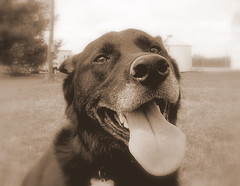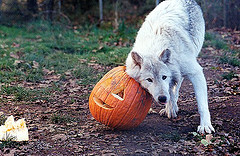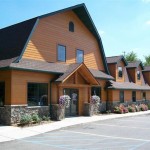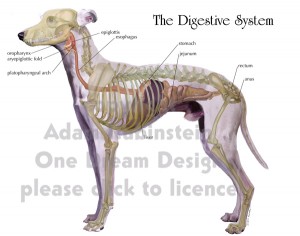Sustainable Pet Food
 Many of us have animals in our lives, either as household pets, working animals or livestock. What we feed them can be a blind spot for some folks in terms of sustainability. Today, I’m focusing on dog food.
Many of us have animals in our lives, either as household pets, working animals or livestock. What we feed them can be a blind spot for some folks in terms of sustainability. Today, I’m focusing on dog food.
[To skip to the sustainable brand I’m using, scroll down to the Earthborn image.]
Remember the huge pet food scare several years back, when dogs and cats were getting sick and dying from contaminated food imported from China? Most of the affected brands were cheaper foods, but not all of them. I’ve always been a bit of a pet food “snob” and have fed my animals from the healthier brands (Wellness, Hund-n-Flocken, and now Earthborn,) so thankfully my girls did not get sick (or worse.)
It was a wake-up call for many pet owners who believed the pet food commercials with the happy dogs eating bowls full of brightly-colored filler and by-products (Protip: Dogs don’t care what color their food is, I promise.)
 In my work as an animal caretaker at a displaced captive wolf sanctuary some years back, I learned a great deal about canid nutrition. Part of the job was looking at wolf poop for signs of illness or parasitic infection, and to see what they had been eating and digesting. As enrichments and treats, we would sometimes feed out carrots, sweet potatoes and many other items of interest to the animals. The day after the carrot and sweet potato treats, we would find nearly-undigested chunks of these vegetables in their scat; the animals’ systems were not equipped to handle large chunks of vegetable matter, and they didn’t get much nutritional value from it. It was still a novelty for them, though, and they enjoyed rolling on the treats and eating them.
In my work as an animal caretaker at a displaced captive wolf sanctuary some years back, I learned a great deal about canid nutrition. Part of the job was looking at wolf poop for signs of illness or parasitic infection, and to see what they had been eating and digesting. As enrichments and treats, we would sometimes feed out carrots, sweet potatoes and many other items of interest to the animals. The day after the carrot and sweet potato treats, we would find nearly-undigested chunks of these vegetables in their scat; the animals’ systems were not equipped to handle large chunks of vegetable matter, and they didn’t get much nutritional value from it. It was still a novelty for them, though, and they enjoyed rolling on the treats and eating them.
Our dogs, while behaviorally removed a great deal from their wolf ancestors, are almost genetically identical to them, and their digestive system is the same. Unlike felids (cats,) which are hypercarnivores (meaning they need at least 70% meat protein in their diets to thrive,) canids have more flexibility in their diets. When roaming the mima mound prairie outside the sanctuary’s perimeter fence, we would find wild coyote poop absolutely chock-full of blackberry seeds, for example. The same was often true of the bear scat I would find out in the woods – berry seeds galore.
Speaking of poop, your dog’s bowel movements will help you to gauge how well the food is being digested. When switching foods, you should typically begin with about 25% new food per serving, and 75% old food. Do this for a few days, then switch to 50% new, 50% old food for a few days. Next, 75% new food and 25% old for a few days, and finally, you can feed exclusively new food. This helps your dog’s system to adjust to the new ingredients in the food. It’s especially important to make a gradual change if your dog has been on the same food for years.
Some dogs will tolerate a 100% shift immediately; others will have bad gas, diarrhea, or abdominal bloating. We feel it’s best to make sure the dog is comfortable and make a gradual change. Mild diarrhea is not uncommon, even when making a gradual change. Provided it abates within a few days of being on the new food 100%, it shouldn’t be anything to worry about; just make sure your pooch has access to plenty of water, and is not panting or whining more than usual.
Contrary to popular myth, it is not unhealthy to change your dog food regularly; in fact, our local pet store owner swears by changing foods every few months to keep dogs healthy, and to prevent food allergies.
 Canids can survive on a meat-only diet, but they are omnivores at heart. Too, our direct observations seemed to indicate they enjoy a little diversity in their diets, as well. Making home-made dog food is a wonderful option for the people who can afford it and who have the time and expertise to concoct the right balance of nutrients for their pets. For some, this is simply a matter of feeding out half a raw chicken carcass (bones and all!) to each dog once per day, supplemented with some ground-up fruit or veggies. Raw bones are great for dogs on every level, but never feed out cooked or smoked bones! Raw bones are pliable and digestible, and far, far less likely to cause punctures, blockages or other gastric tract injuries. Cooked bones can break into sharp, deadly splinters that can cause massive, painful and expensive internal damage.
Canids can survive on a meat-only diet, but they are omnivores at heart. Too, our direct observations seemed to indicate they enjoy a little diversity in their diets, as well. Making home-made dog food is a wonderful option for the people who can afford it and who have the time and expertise to concoct the right balance of nutrients for their pets. For some, this is simply a matter of feeding out half a raw chicken carcass (bones and all!) to each dog once per day, supplemented with some ground-up fruit or veggies. Raw bones are great for dogs on every level, but never feed out cooked or smoked bones! Raw bones are pliable and digestible, and far, far less likely to cause punctures, blockages or other gastric tract injuries. Cooked bones can break into sharp, deadly splinters that can cause massive, painful and expensive internal damage.
 For most of us, feeding a home-made dog food just isn’t a viable option – it is more expensive, less convenient and more time-consuming. There are excellent raw dog foods out there, which are fantastic options – if more expensive. They contain raw meats, fruits, veggies (and sometimes grains) which must be kept refrigerated or frozen to remain fresh. Most dogs love these foods! I occasionally pick up a tube for my girls as a nice treat and change of pace. I freeze it and give it to them still frozen, so it will last longer (I feed it outside so it doesn’t ruin the carpets.) These dog foods are sometimes called a BARF diet – Bones and Raw Food (or Biologically Appropriate Raw Food, for some.)
For most of us, feeding a home-made dog food just isn’t a viable option – it is more expensive, less convenient and more time-consuming. There are excellent raw dog foods out there, which are fantastic options – if more expensive. They contain raw meats, fruits, veggies (and sometimes grains) which must be kept refrigerated or frozen to remain fresh. Most dogs love these foods! I occasionally pick up a tube for my girls as a nice treat and change of pace. I freeze it and give it to them still frozen, so it will last longer (I feed it outside so it doesn’t ruin the carpets.) These dog foods are sometimes called a BARF diet – Bones and Raw Food (or Biologically Appropriate Raw Food, for some.)
So where does that leave the rest of us? Those who are on a tighter budget than a homemade or raw diet might allow?

We all have to find options that are right for our particular animals, budget and ethics. Some dogs have food allergies (most commonly beef, chicken, soy, wheat, and corn) either from birth or from having been fed the same food for years, some have genetic disorders requiring a special diet – make sure you consult with your veterinarian about what food is right for your pet if you know about or sense any abnormalities in your animal.
As I mentioned before, I have used several quality dog foods over the years. I started out with Solid Gold Hund-n-Flocken lamb & rice. This is a high-quality food. From their website: “The ingredients we use are USDA Choice, range fed lamb and USDA Grade 1 and II grains. Our lamb is free of all hormones and medications, and the grains are bought with a guarantee that they are free of pesticides.” My dogs were on this for several years and did very well with it.
When I moved back to Michigan from Washington state, though, I couldn’t easily find that brand. I switched to Wellness Super 5 lamb. From their website: “True Wellness comes from an ideal nutritional balance – never ‘empty calories’. True Wellness is about being more than natural – every ingredient has a purpose. True Wellness means real quality control – only trustworthy sources. True Wellness comes from carefully chosen, authentic ingredients.” I fed this food for five years, at which point my husky mix began developing severe allergies. They are most likely not food-related (but rather pollens, molds, and other contact allergens,) but she was so miserable and itchy I wanted to make sure her food was not amongst the culprits.
Initially, I briefly switched to Wellness Rice & Salmon allergy formula, but I wasn’t crazy about about using salmon, which are over-fished. As I walked into my pet food store a few weeks ago, I saw a new food on the shelves with a bunch of laminated informational pages. I was hooked immediately upon reading through! Thus, my new pet food is:
This formula uses more sustainable fish (whitefish and menhaden) over salmon. From their website: “Ocean Fusion is a great alternative food for your adult dog. Whitefish meal and menhaden fish meal are the only animal protein sources in our Ocean Fusion formula. Fish is a unique protein for most dogs, making it a great dietary alternative. Our unique whitefish and potato formula contains fewer protein and carbohydrate sources than most formulas, making it easy to manage your dog’s dietary needs.
Barley and rye are wholesome grains that are easily digested and are a good source of natural fiber, which helps maintain a healthy intestinal tract. L-carnitine helps convert body fat into muscle and energy, supporting lean muscle mass and body conditioning. Balanced Omega-6 and Omega-3 fatty acids play a vital role in establishing the lipid barrier of the skin, supporting your dog’s healthy skin and coat.
Made with our high-quality ingredients and processing technology, Ocean Fusion provides excellent digestibility and nutrient absorption. Ocean Fusion is 100% guaranteed for taste and nutrition for adult dogs.”
The company engages in sustainable practices, which you can find on their website. They’ll even plant trees for UPC codes you send in!
For dogs with grain sensitivities, they also have a variety of grain-free formulas available.
Their website specifies their packaging is made in the US, but I didn’t see anything about where the food itself is produced. Thus, I sent in an email asking. Within a half hour, the vice president of marketing had responded: “All Earthborn dry pet food is manufacted in our company owned manufacturing plant in Monmouth, Illinois.” Outstanding!
There are, of course, other quality dog foods out there, and I have tried just about all of them at one point or another. For me, it all comes down to these factors:
- Is it healthy for my dogs?
- Is it being properly digested? (it all comes back to poop – the more food absorption occurs, the less poop there is, and it should always be firm and well-segmented)
- Are their coats looking healthy, meaning they are getting proper nutrition?
- Is the food source sustainable (and preferably not factory-farmed?
- Is the food produced in this country, and not in China, where quality controls are virtually non-existent?
Earthborn fits the bill perfectly. I’m very happy to have found a sustainable brand which offers allergen-specific formulae.
What do you feed your pets? Does sustainability enter into the equation for you? Do you have allergies you must account for?



1 thought on “Sustainable Pet Food”